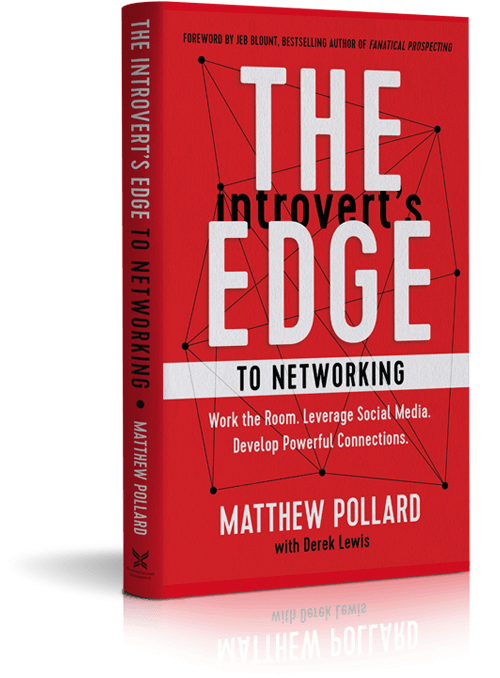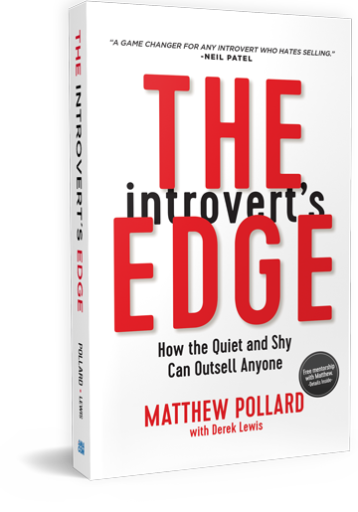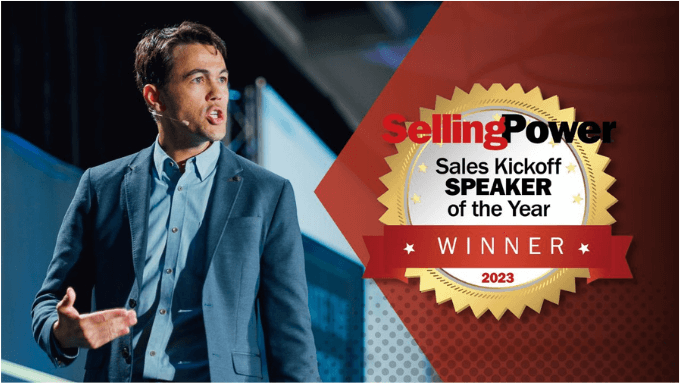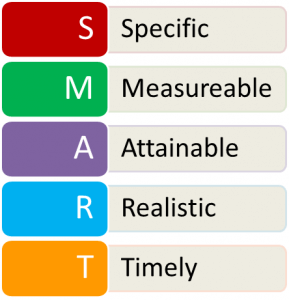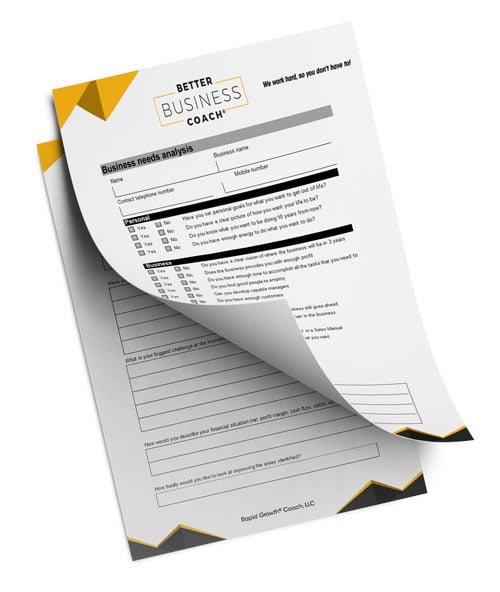Better Business Coach Transcript
This is Better Business Coach Session Number 17
Welcome back to Better Business Coach. My name is Matthew Pollard and, as always, I am Your Rapid Growth Guy. Before we get started today, I just want to take a second to apologise for not producing any content outside of the interview with Dev Singh for the last two weeks. Unfortunately, I’ve been incredibly ill – I’ve had the flu and I just haven’t had a voice to be able to produce content. And I’ve been feeling so, so depressed about not being able to provide it, especially considering how many wonderful emails I’ve been receiving thanking me for the content. And that’s just made me feel so, so overwhelmed that people are getting such value out of this content. It really has driven me back in front of the microphone to be able to provide new content much sooner. What I’ve been hearing from all these emails, as well, is that people are getting great results with this content. They’re using it with clients and they’re getting success. They’ve told me that they’ve been able to ask for higher-dollar hourly rates. They’ve told me that they’ve been able to successfully transition clients into paid clients much more easily. They’ve told me that they’ve been able to talk to clients in networking events and actually book in Business Needs Analyses, and that’s just fantastic! It’s so great to be able to hear that people are getting such wonderful results. It made me so happy, and it’s really pushed me out of bed and put me back in front of the microphone. And I’m so happy be sharing with you some new content today.
Before I get started, we’ve managed to stay in New and Noteworthy, which has been terrific, and that’s all to do with the fact that we actually received more downloads and more subscriptions in the last few weeks than in the first few weeks of our podcast just because people are getting so much value out of this. However, I would love it if you take a second to hop on betterbusinesscoachpodcast.com, click on the iTunes link, and post a review with a four or five star rating. If you’re on an iPhone and you’ve got your podcast app, please just hop on the app to the Better Business Coach Podcast and post a review with a four or five star rating there as well. That will signal to iTunes that you’re getting a lot out of this podcast, and that will allow them to drive it up in New and Noteworthy and allow more people that are in your situation to get great results out of this podcast because they will find it and it’ll be utilised in their businesses as well. Thank you for that in advance.
And now I’ll move straight into the content because I know especially from all these emails I’ve been receiving that people have been craving the next piece of content. So I’m actually going to share with you a little bit of a surprise. This is a task that I wasn’t planning on sharing, and this is a task that I use between my first free session and my first paid session. Now, people that listened to Session Number 14, they’ll know that they always need to set their first session a week or two in advance of their free Business Needs Analysis. And for people who haven’t listened to Session Number 14 go back and it’ll give you a full, detailed explanation for why you set it that far ahead. Also, in that podcast, it talks about getting payment on the day and I want to make sure that people understand that they do not set this task until they’ve received and processed payment. So, what I do if I’m sitting in a face-to-face meeting is that I will tell them that when I get back to the office, after I’ve processed a payment, I will send them a task, and I give them a brief explanation of what the task is. When I’m on the phone, I process the payment and I say to them when I get off this phone call, or very shortly afterwards, I’m going to be sending them a task. And what I do is, I give them a brief outline of the task and I say I’ll be sending them a request for six goals: three of them will be business goals, and three of them will be personal goals. One of those personal goals has to be selfish to them, and the reason why I tell them that is it gives them a license to be selfish. You’ll find a lot of people won’t be unless you tell them to do so. I always find that that goal is the one that drives them most of all. Now, why do I ask them to set three business and three personal goals? They could set hundreds and, obviously, as you start to coach them, they will. What I’m really looking for, is, I’m looking for a high-level view of what they’re trying to achieve. And you will be able to hold them accountable to that, and it will also create crystal-clear or laser focus – if you like – around what you’re trying to achieve for them as a coach.
How to Set Goals
Now, why are goals so important? And obviously there’s a hundred years of research to support that businesses – regardless of geography or market conditions – do well if they have goals. If they don’t have goals, they struggle and fail. In fact, Earl Nightingale has said “people with goals succeed because they know where they’re going.” It’s as simple as that. And we know there is a direct correlation between goals and a successful business. So what we want to do is make sure that they set these goals before we even start, so we know what they are, and we can start making sure that they make headway towards those goals. And what you’ll find is, the process that we follow which I will give you a quick summary, this is the summary that you should be giving before you send the email, and that is – “I want you to go and set three business goals, three personal goals – one selfish to yourself – and then, what I want you to do is use the SMART criteria.
And I say the most important ones of that are Specific, Measurable, and Time-based. Now I’m going to go through the whole SMART criteria in a second; I just want to make sure that you don’t go into huge amounts of explanation around this. When you speak to the client, you tell them that you’ll send an email – again, once you’ve processed payment. Then, I tell them that the SMART goals, while important, are nowhere near as important as the second part, however, are required for part two. And part two is where they write down why that goal is important to them. And then I share with them that so many people – especially high performers – will fly through writing the goals down, and they’ll have them all done, and then they try and write down why it was important to them, and they will figure out that it actually isn’t important to them. It was what their brother/ sister/mum/dad/uncle/drunk best friend said to them one time that they should be trying to achieve, and all of a sudden they’ve embraced that they’re now trying to achieve it, but they’re not congruent with it. It’s not truly what they want. So the process of setting these goals really helps create a crystal-clear clarity around what they want, or a laser focus if you like, so that you can make sure, as a coach, that you’re helping them achieve what they truly want. That’s about as much as I speak about it, and I just ask for a commitment that once I’ve sent that email that it is sent back to me – the responses around those goals and why statements in 250 words or less, no more, at least 24 hours before our first session. And that allows you to get them, read them, and become completely immersed in what you’re trying to achieve for that client.
Now why do I say 250 words or less? The first reason is I don’t want to read 500 pages of goals! I’m a business coach charging per hour, and this I’m not charging for, I’m just going to read content. So I can’t sit there for 500 pages reading goals. And trust me, people will provide that many words if you don’t restrict it. Secondly, I want these people to read and align with these goals on a daily basis. I want them every morning to pick up their three business goals and their three personal goals and read over them. And before they set their agenda for what they’re going to do the night before, to read over them and go “okay, I’m now aligned with what I want to achieve,” and put everything through that specific objective microscope of “will it help me get to my goal? Well no, that task’s not important.” Otherwise people could have done that task and they’re not creating energy towards the goal that they want to achieve. So 250 words or less actually allows them to read them every day, be aligned with them and, as a coach, for you to read over them before you speak to any client on any day and make sure that you could hold them accountable to those specific goals. So 250 words or less has a lot of value and for people who have read One Minute Manager, this is directly out of One Minute Manager. And it works so well, so let’s not reinvent the wheel: stick to 250 words or less. If people send you 500 words, send them an email back and say “look, can you refine these because they’re not well structured or they’re too long for you to use on a daily basis.” And again they’ve already paid you for the first sessions of coaching, so they’re going to want to make sure they provide you the right information before you get started.
SMART Goals
So, now what I’m going to do is, I’m going to run you through the SMARTcriteria, but I’m going to do it very, very quickly because you shouldn’t provide them huge amounts of information. Again, all you’re trying to do is get the high-level plan. When you start doing paid coaching with them, you are obviously going to set more specific goals on how to obtain those higher-level goals. But we’re not talking about that at the moment. You haven’t even coached them yet, and they probably won’t understand the true purpose of everything that you doing just yet. So, what we want them to focus on is just setting goals that fit specific criteria that are higher level and we only want to focus on six.
So the first one is Specific, the second is Measurable, the third is Attainable, the fourth is Realistic, and the fifth is Timely. And that’s what makes up SMART. So let’s look at how that breaks down. And, again, you should write something to this effect – and if you’re not much of a writer, what you’ll be able to do is go to matthewpollard.com/BBC017, which is the show notes of this page. And what I should also mention, why I’m talking about show notes is, the people who are just listening to this podcast and checking the quick notes at the start on the iTunes listing, or if you listen to it on Android, what the listing is there, make sure you go to betterbusinesscoachpodcast.com. On there, you’ll see like a jukebox which will highlight each one of the episodes. But at the end of each one of the jukebox entries there is a Read More button, and if you click that Read More button, you go to this whole lot of show notes that I prepared for you for each and every episode. So, for instance, in Session 2 and 3 where we discussed elevator scripts and conversational elevator scripts, there are actually examples there that you can utilise within your business. I know I’ve talked about how you can download the worksheets; however, each one of these episodes you can access through the jukebox and go to a full explanation. And a lot of times there are actually additional notes that I haven’t shared in the podcast that you’ll be able to access through that. So what I would like you to do it is take an opportunity to have a look at just how easy it is through betterbusinesscoachpodcast.com, and then go into any of the Read More’s in the jukebox that you’ll see there, and you will be able to read full show notes. And for this one, I’ll specifically create a short link for you to type in: matthewpollard.com/BBC017. That’ll allow you to go straight to the show notes and copy and paste, if you like, this as an email to your clients. You might have to do a few changes to make it from a show note into an email, but it’ll put you 90% of the way there. However, Specific is all about setting an actual number goal. For instance, I want to be able to produce 20 appointments every single week out of telemarketing perhaps or out of advertising. You want to be able to increase turnover by 200%. You may want to be able to work only 20 hours a week so you can spend more time with your family. These are all Specific goals.
The next one is Measurable. If you set a goal that isn’t that specific – for instance, “I want everybody I run a seminar for to leave happy” is a very hard goal to figure out whether you’ve achieved it or not because there’s nothing really tangibly measurable about it. However, if I say “I want to increase revenue by 20%,” or “I want to increase turnover by 200%,” they’re very measurable goals, so that will allow you to get a lot more success out of it.
The third one is Attainable. Achievability is so important, especially for new start-ups, because a lot of people will set ridiculous goals, like “I want a $5 million business in the next 12 months,” but they may be operating from a storefront that doesn’t give them the ability to do this. Now, that’s fine, you can set a multi-million dollar target if you’re going to change the way you go about selling your products and services, and that may be one of your other goals; however, if you only want to do storefronts, you need to make sure that you’re able to achieve a target that you’re setting yourself. One other subnote here is a lot of people also will set themselves targets that are too low because in their mind they just want to get some sales. For instance, I know a few writers that say “I just want to get paid to write. If I got paid to write, I’d be truly happy.” However, they forget they still have bills to pay, they still have to pay for their car, their rent, their phone bill, everything. And plus, now they have to pay for the ability to do business, and that could be offices, websites, all sorts of things, and that’s not going to allow them to earn the revenue that they need. Just being paid is not a goal that is going to work. So you do need to set a goal that is going to make sure that, longevity, you’re going to stay in business. So, while you want to make sure you don’t set unachievable tasks, you also need to make sure you don’t set the bar too low for yourself. And this is what you want to be telling your clients. Again, I don’t focus too much on Achievable; I’m just giving you an understanding of how to frame it if a client asks.
Next – and I would not suggest talking about this again with your client; I generally focus just within Specific, Measurable, and Timely; however, they can also look at what the market worth is, the rate of competitors going into the market, the market growth in the last quarter, last year, the past five years, if there’s any projections, whether there are any new players coming into the market with new technologies perhaps. And all of this will become a lot more clear in the SWOT Analysis, which is a session and a worksheet that I will be giving away to you in just a few sessions’ time. However, again, in this specific session you’re really just trying to give them a task so you can be aligned with what they want to achieve. So I want you to understand SMART goals; however, don’t spend too much time focusing on explaining each one of the elements.
The fourth one is Relevant. And you need to make sure that the goals they are setting themselves are relevant to the business that they’re actually running. For instance, a lot of people tell me that they want a website that looks great and people want to buy off their website. However a lot of people don’t sell things online, so the website is purely about credibility. Yet they’re talking about e-commerce, and chat sites, and forums, and a lot of time it is just not relevant to what they’re doing as a business. Now 42% to 43% of businesses, as I say this today, don’t have a website. So it’s vitally relevant that they have a website for their business because it provides that level of credibility. And again, a lot of people won’t bring this up in their three business goals and in their three personal goals. This will be a result of the work you do with them later. However, I just try to explain that relevancy is massively important. If it is not relevant to what they’re currently doing in their business, then there is a massive issue there and they need to redo that goal. So this will pop up and show them quite frequently that they need to reset or rethink how they structure their goal. One other thing that pops up here in relevancy quite frequently is people have conflicting goals, and they’ll find by writing their why statement later, which we’ll discuss, that this will pop up and they’ll have to rethink. For instance, if somebody says “I want to travel all the time. And as a result, I will do anything in my business goals to make sure I can travel a month out of every four” and I said to them “okay, if you had to be a garbage collector three months out of every four so that you can travel, would you be willing to do that,” you’ll get the answer, “No.” So again, one goal isn’t relevant to the other and you need to make sure that there is a connection there. Again, this is not stuff that you’re going to teach a client, you just want to be aware of this stuff so that when you’re looking at the goals, you can say “okay, there is confliction here” before you get on and do your first call with the client or the first visit with a client.
The final one is Time-based, and this is the most vital. See, so many people will set themselves goals without actually setting a time limit for when they want to achieve them. For instance, if I say “I will increase revenue by 200%,” that can be done at any time. And what we know about setting goals without time-basis is that it just goes into the World of Tomorrow. The World of Tomorrow is this wonderful world we all know of where things just never happen. And that’s a horrible place for any goal to be. So what we want to do is make sure that every goal has the timely element to it. Now, again, I’ve gone into detail here because in the future you’re going to have to teach your clients how to set real SMART goals; however, in this specific instance, what I really want to focus on is Specific, Measurable, and Timely. So I’m going to go through some great examples here. For instance you want to increase turnover by 20% in the next six months. You want to get 20 appointments per week in the next month, and every week after that. You want to start working only 20 hours a week by December of 2017. Now, again, these are all SMART goals. Now, the most vital part here is that they write straight after that why it’s important to them. Because if it is not important to them, they won’t get behind it, they won’t push to achieve it, and you’ll be pushing them, and they’ll hate you for it. Whenever they know why it’s important to them, they will love you for the fact that you’re pushing them to achieve what they truly want. So make sure that they know that they need to write down why.
So, in summary, you will tell a client that you will send them an email – and again go to the show notes at matthewpollard.com/BBC017 and you’ll be able to create the email from that – however, tell the client that you want them to set three business goals and three personal goals, one of which is personal and selfish to themselves. Each one of those goals needs to be summarised within 250 words or less using the SMART criteria and what you really want to say there is that it’s only Specific, Measurable, and Timely, which are vital, and you’ll summarise that a lot more in the email. Then, more importantly, that’s only to get to the Why statement of why it’s actually important to them and explain that so many people will chase goals that are important to their mum, their dad, their brother, their sister, their drunk uncle that mentioned something about a Christmas event or something like that, and you want to make sure that you’ve got crystal clear focus, or laser focus, on what they want to achieve for them, to make sure that you generate the result that they’re looking for. That’s really the whole task of what you want to set for clients. Now I also generally will set, depending on the program, something else as well. For instance, my Get More Customers program, which is a connection of three of my best rapid growth sessions, I also set a task where I have them give me an understanding of their customer profiles and their ideal market, and there’s a whole lot of homework for that as well; however, that’s to make sure that I can get success for that specific program. For what you’re doing here, this should be enough. You’ve done the Business Needs Analysis; then, as a result of this task, you know what goals they are trying to achieve, and you know to crystal clear clarity that they want it, and why. Your next session with them is going to be an absolute breeze.
So, I hope you’ve enjoyed this session. If you’ve got any questions, also, feel free to email me at Matthew@Matthewpollard.guru. I would love to answer any questions that you do have. And, please, if you haven’t already, please take a second and post your review on iTunes by either going to the link Matthewpollard.guru/BBC017 and clicking on the iTunes button that will be provided there with the show notes, which will also have the basis of the email you need to send you clients, or if you’re on an iPhone go to the iPhone app and type in Better Business Coach Podcast and post a review with a four or five star rating. I really appreciate it. We’ve only got two weeks left of being in New and Noteworthy to really get noticed. And, as I said, I’m seeing that so many people are getting great results out of this, and it just made me feel fantastic to be able to provide this level of content to people. So, please, take a second, I really will appreciate it, and post a review. And make sure if you’ve got questions that you email me at Matthew@Matthewpollard.guru. I look forward to hearing from you, I look forward to reading your reviews, and more than that, I look forward to sharing with you the next content I have planned on Better Business Coach Podcast. Cheers!








